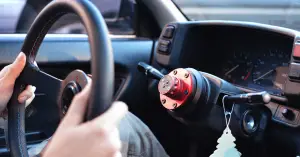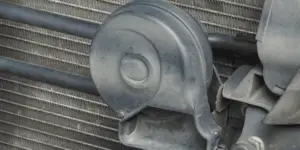
When your car horn honks for no reason, it’s embarrassing, annoying, and can cause an accident. Car horn technology is so basic that we don’t even think about it and expect everything to work smoothly until something goes wrong.
If your car horn keeps beeping every time you turn, there’s a fast way to stop it until you can investigate the situation. Sometimes, it’s as simple as pushing the horn again until a bad switch comes unstuck, but that won’t always fix the issue. In most cases, it’s best to take your car to a trusted mechanic.
However, there are several key things that you can check and fix at home with a little effort to save you time and money. Discover the top 5 reasons why your car horn might go off when you turn the steering wheel and how to fix the problem.
What You’ll Need
- Your car’s owner’s manual
- A multimeter
- An ohmmeter
- A test light
5 Ways to Fix Car Horn that Goes Off When You Turn the Steering Wheel

1. Check if the Horn Switch is Broken
You can often perform this kind of diagnostic without any tools if you’re a car wizard. But you’ll most likely need to use a few basic diagnostic tools for your vehicle.
Before you get started, check your owner’s manual to see if your vehicle integrates the airbag with the horn switch. If it does, take your vehicle to a professional mechanic. That’s because trying to test or remove the horn switch can deploy the airbag, causing a dangerous or expensive airbag module situation.
The first important tool that you’ll want to have on hand is a multimeter. You can also use a test light when checking for the presence of power. However, an ohmmeter is a more specialized tool that can help you check for continual electrical resistance. You should use an ohmmeter if you need to test your horn switch’s functionality.
Replacing the Horn Relay
Sometimes, another nearby circuit might have an identical relay that you can swap into the horn relay socket. Get back behind the wheel and test if the horn still honks when you turn it. If it doesn’t honk, then you know that the problem lies in the horn switch. If that’s the case, all you need to do is buy a new horn relay and insert it to solve the problem.
On the off chance that your car doesn’t have an identical relay, you’ll need to check both the horn relay and switch. If the relay shorts out inside, then all you need to do is replace the relay to get rid of the issue. If you can’t identify an internal relay short, then take out the relay and look at the wires that connect to the horn switch. Use your multimeter to see if there’s electrical continuity joining the wires.
If your multimeter shows a constant electrical current between the wires, just push on the horn button to check for any changes on the multimeter.
If the switch is in working order, pushing the horn button or pad inside your vehicle should cause a change in the reading on the multimeter. Next, check your car battery to see if it is weak, dead, or disconnected. Sometimes, you can fix the issue by punching button combinations on your alarm remote or clicking the remote while inserting the key in the ignition.
Keep in mind that fixing a car horn that honks while turning can be tricky and procedures can vary based on your vehicle’s manufacturing specifications.
2. Check for and Disconnect a Pinched or Damaged Wire

The next thing to check for is a pinched, damaged, or loose wire. This can occur either inside the horn, in the actuator, or somewhere in the steering column.
Your car horn works as a basic grounding circuit that sends power to the horn relay “clockspring” or spiral cable. The horn switch keeps the coil grounded which enables the relay to turn on. If your horn still goes off after inserting the fuse, disconnect the spiral cable that connects to the side column of the steering wheel. This will let you know if the issue is in the steering wheel column or somewhere else in the car.
If the horn still blares with the spiral coil disconnected and the fuse replaced, then a bad horn relay is the most likely cause. Usually, this means that the relay is stuck in a closed position. If your car type doesn’t have an integrated horn and airbag module, just loosen the airbag and remove the horn grounding wire. If you’re not sure what this looks like, it should look like a single wire that a fastening connector that links the airbag and the clockspring coil.
Clockspring Failure
Once you’ve done this, test your horn again. If it still blows with the grounding wire disconnected, then you know that the problem lies in the clockspring. This is most likely from a weak or broken spring beneath the airbag module. This enables the contacts to touch intermittently when they should not connect.
In most cases, a clockspring failure isn’t the cause because they usually fail in an open-circuit, not a closed-circuit manner. When this happens, a car horn just stops working. An intermittent horn going off when turning the wheel often indicates a collapsed spring or short in the horn wire.
3. Look for a Wire Short in the Steering Column
The third way to troubleshoot your car horn to test for a wire that may be shorting out.
It’s a little tricky to identify the exact spot where a wire is shorting. The first place to check is the dark, green-colored wire that follows the steering column down to the horn relay. If the horn doesn’t honk when you push the horn button before disconnecting the relay, then this suggests that the wire has shorted or broken near the horn bearing ring located at the top of the steering column.
You can look for a break/short in the wire by examining the dark green wire emerging from the steering column.
4. Check if the Horn Wire Bolt or Column Tab is Loose or Rubbing
Sometimes, the answer lies in the nuts and bolts. For example, you can remove the steering wheel and check the steering column to see if the bolt that holds the spiral wire is loose or chafing. If the bolt is rubbing against the wire and causing the honking, you can grind down the bolt head slightly.
Another culprit is the brass ring that sits on the top bearing in the steering column. It has three tabs to hold the ring in position. Sometimes, one or more of these tabs can loosen and cause issues. You can identify this by checking if the ring or the tabs have risen above the surface. Just glue the pesky tab back in place to get rid of the problem.
5. Readjust Your Steering Wheel Column Position

Another reason that can make your car honk is that the steering wheel is sitting too far down the column. When the steering wheel is tightened further down the shaft, it can allow the horn contacts to touch more often. This may cause honking when you turn the wheel.
Use a steering wheel puller to pull the wheel out a little until the horn stops honking when turning. In some cases, the steering wheel may be misaligned or torqued in the wrong way. Just pull back on the wheel and adjust it back about 1/32 of an inch.
Sometimes, a rag joint issue can also cause a honking problem. Locate the rag joint and ensure that the steering column is extended toward the front of the car. Next, loosen the pinch bolts and slide out the serrated segment.
If there’s too much play happening between your upper and lower steering column bearings, have someone hold the lower section against the upper. While they do that, move the preload spring and fasten it at the lowest bearing setting. Wait until it’s practically 100% compressed. Leave a slight gap between the spring coils, then tighten the lower rag joint to cure the horn honking issue.













